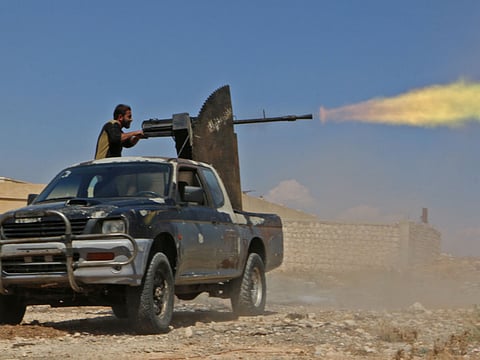The triumph of the pick-up
It’s reliability and manoeuvrability have made the ubiquitous light-weight truck the battle vehicle of choice worldwide

Anyone who watches international news is likely to have noticed this about conflict zones and battlefields. From the jungles of Central America to the African Sahel, and from the plains of Syria to the mountains of Pakistan, all militants and insurgent groups move around in one type of vehicle: a lightweight, Japanese-made pick-up truck. In the Third World, the pick-up is to war vehicles what the AK-47 is to weapons — ubiquitous. Not only militant groups, but also national armies and police forces in developing countries, especially in the broader Middle East, use the pick-up.
In 2006, producers of the widely-watched British motoring show Top Gear — the original version, featuring the superhit trio of Jeremy Clarkson, James May and Richard Hammond — decided to carry out a unique experiment to find out why the pick-up is so popular with insurgents. They bought a Toyota Hilux from a farmer for $1,500. It had 190,000 miles (304,000km) on the odometer, and subjected the pick-up to an insane variety of tests. They wanted to find out if it would still start and move after these tests, with the mechanic allowed to use only basic tools like spanners, duct tape, and WD-40, but no spare parts.
The pick-up was driven into a tree; down the stairs; submerged in sea water for hours; smashed with a wrecking ball normally used to fell skyscrapers; driven through a portable work studio; had an RV dropped on top of it; and was then set on fire. Each time, to the amazement of the mechanic and cheering crowds, it started and moved.
In the final test, the vehicle was placed on top of a 240-feet tower block slated for destruction with dynamite, and came crashing to the ground alongside tonnes of concrete. And, yes, it still started. An astonished Top Gear team decided to set it up on a plinth in their studio “for eternity”.
Apart from its legendary reliability, the Hilux’s manoeuvrability, its excellent 4WD system, and easy availability worldwide of cheap spare parts render it the preferred choice for guerrilla forces and national armies in many parts of the developing world.
Its solid axle design and extremely strong frame make it the perfect vehicle for uneven terrain. All these characteristics are ideal for the hit-and-run tactics often adopted by irregular fighting forces. The ruggedness of the chassis enables militiamen to mount heavy machine guns or anti-aircraft guns or portable rocket launchers atop the pick-up. In the absence of these weapons, the same space is used to transport up to a dozen insurgents or soldiers at a time.
Consider a battlefield scenario: A bunch of militants or a few heavy weapons need to be transported through a dodgy bridge across a river. While this bridge may not be able to support an armoured personnel carrier, like the BMP, or a battle tank weighing several tonnes, a nimble pick-up truck can easily cross it. And the advantages against the tanks do not stop there.
YouTube is replete with battlefield footage from the Syrian war and the Libyan uprising of insurgents using rocket launchers mounted on pick-ups to target tanks, and even employing anti-aircraft guns mounted on the vehicles to bring down military helicopters or low-flying MiG fighter jets.
What’s more, there’s an entire war named after a pick-up truck. The ‘Toyota War’ was the name given to the last phase of the border conflict between Libya and Chad, in 1987.
During this phase, in 1986, Libya occupied the northern, mineral-rich areas of Chad. The Libyans had 8,000 men, 300 Soviet-made, state-of-the-art T-55 battle tanks, and fighter aircraft. The Chadians had 10,000 soldiers, and 400 Toyota pick-ups, mounted with the MILAN (Missile d´infanterie léger antichar) anti-tank guided missiles supplied by their French allies.
The end result was a devastating and humiliating defeat of Muammar Gaddafi’s army at the hands of the numerically and technologically inferior Chadian forces who, nevertheless, used the pick-ups to great effect, destroying almost all the Libyan tanks, and killing 7,500 Libyan troops, while losing only 1,000 of their own.
Donald Rumsfeld once said that you go to war with the army and weapons you have, not with the army you want. The militias of this world seem to have heeded his advice. The continued prevalence of pick-ups, and weapons like the AK-47 and RPGs in just about every conflict across the world, shows that people will employ all means at their disposal to try and even the odds.
Sign up for the Daily Briefing
Get the latest news and updates straight to your inbox


